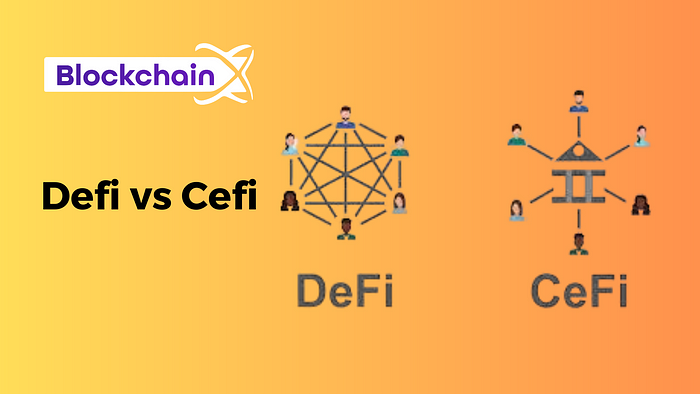When comparing DeFi vs CeFi (Decentralized Finance)(Centralized Finance), there are several key differences to consider:
- Control and Intermediaries:
- DeFi: DeFi platforms operate on decentralized networks, with transactions and financial activities executed through smart contracts. There are no intermediaries involved, and users have direct control over their funds.
- CeFi: CeFi platforms are centralized and typically operated by intermediaries such as banks, exchanges, or financial institutions. Users rely on these intermediaries to manage their funds and conduct transactions.
1 Trust:
- DeFi: DeFi is designed to be trustless, leveraging blockchain technology and smart contracts. Transactions are transparent and verifiable on the blockchain, reducing the need to trust a central authority.
- CeFi: CeFi platforms require users to trust the centralized entities that manage and control the financial system. Users must rely on the integrity and security measures implemented by these intermediaries.
2 Accessibility:
- DeFi: DeFi platforms generally have a more open and inclusive nature, as they often have lower barriers to entry. Anyone with an internet connection can participate, regardless of their location or background.
- CeFi: CeFi platforms may have restrictions, such as geographical limitations or KYC/AML requirements. Access to these platforms is typically subject to the policies and regulations set by the centralized entities.
3 Innovation and Flexibility:
- DeFi: DeFi is known for its innovation and flexibility, as it allows for the creation of new financial products and services through smart contracts. Developers can build on existing DeFi protocols, enabling a wide range of decentralized applications (DApps) and financial tools.
- CeFi: CeFi platforms may be slower to adopt new technologies and innovations due to their centralized nature. Changes and updates to the financial system often require approval from the centralized entities.
4 Risks and Security:
- DeFi: DeFi introduces unique risks, such as smart contract vulnerabilities and potential hacks. Users must be cautious when interacting with decentralized protocols and carefully assess the security measures in place.
- CeFi: CeFi platforms are subject to traditional cybersecurity risks, but users may also face risks associated with the custodial control of their funds by centralized entities. Trusting third parties with asset custody can expose users to counterparty risk.
Both DeFi and CeFi have their own advantages and disadvantages, and the choice between them depends on individual preferences, risk tolerance, and specific use cases. DeFi offers greater decentralization, transparency, and accessibility, while CeFi provides established infrastructure, regulatory compliance, and familiarity with traditional financial systems.

CeFi and DeFi refer to two different types of financial systems:
- CeFi (Centralized Finance): CeFi stands for Centralized Finance, which represents traditional financial systems that are centralized and controlled by intermediaries such as banks, exchanges, and other financial institutions. In CeFi, these intermediaries act as trusted third parties that manage and facilitate financial transactions. Users typically rely on these centralized entities to store their assets, conduct transactions, and access various financial services. CeFi platforms often require users to undergo KYC (Know Your Customer) and AML (Anti-Money Laundering) procedures, as they operate under regulatory frameworks.
- DeFi (Decentralized Finance): DeFi, on the other hand, stands for Decentralized Finance, which is a newer and rapidly growing concept that aims to provide financial services using decentralized blockchain networks. DeFi operates without intermediaries, allowing for peer-to-peer transactions and eliminating the need for traditional financial institutions. It leverages smart contracts on blockchain platforms like Ethereum to enable various financial activities such as lending, borrowing, trading, and asset management. DeFi platforms often rely on tokenization, where assets are represented by digital tokens on the blockchain. DeFi also promotes transparency, accessibility, and open participation by anyone with an internet connection.
Key differences between CeFi and DeFi include:
- Control: CeFi platforms are controlled by centralized entities, while DeFi platforms are governed by smart contracts and decentralized protocols, with decision-making power distributed among the participants.
- Intermediaries: CeFi relies on intermediaries such as banks, exchanges, and financial institutions, whereas DeFi eliminates intermediaries, allowing users to interact directly with the protocol.
- Trust: CeFi requires users to trust centralized entities to manage their assets and conduct transactions, while DeFi relies on the trustless nature of blockchain technology and smart contracts.
- Accessibility: CeFi platforms may have restrictions, such as KYC/AML requirements or geographical limitations, whereas DeFi is generally more accessible to anyone with an internet connection.
- Transparency: DeFi promotes transparency by providing open access to the blockchain’s transaction history and smart contract code, while CeFi platforms may not always offer the same level of transparency.
It’s worth noting that while DeFi offers numerous advantages in terms of accessibility and innovation, it also comes with its own set of risks and challenges, such as smart contract vulnerabilities and regulatory uncertainties.